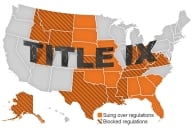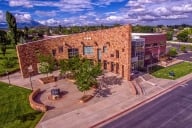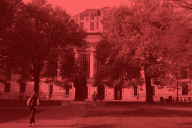You have /5 articles left.
Sign up for a free account or log in.

Istockphoto.com/FPM
Happy Monday. More states and cities are requiring people to wear masks for trips to the grocery store (or just everywhere), and leaders are planning for how, exactly, the world will work once stay-at-home orders are lifted.
While things don't seem much better than last week, there are always some palate cleansers to cheer us up.
Here is a delightful story on chatting with a cat over FaceTime. I am happy but also sad reading it, as our perfect foster pup, Kane, has found his forever home and left ours empty.
This piece of digital art is not exactly PG, but I think it perfectly captures what some of us are feeling right now.
Below, you'll find our now-weekly Q&A feature. This time I talked with Phil Regier, dean for educational initiatives at Arizona State University and CEO of EdPlus.
Now let’s get to the news.
In general, the economy isn't doing so hot. But, unsurprisingly, a study found that those with college degrees are faring better than those without right now.
Another survey found that black and Latinx students are facing more challenges, like job losses, right now than their white peers.
Technically, wage garnishments for student loan payments are not allowed right now. But some people are still reporting this issue. The Education Department says it's doing what it can to stop this.
Leaders at the Vermont State Colleges are proposing three campus closures as the system feels the financial strain of the pandemic.
Here’s a quick roundup of our latest stories, in case you’ve fallen a bit behind (we don’t blame you):
For-profit colleges got aggressive in recruitment in the last recession. Kery Murakami reports on how some advocates worry history will repeat itself.
College libraries, most of which haven't fully recovered financially from the last recession, are bracing for another round of cuts, Lindsay McKenzie reports.
Elizabeth Redden has a story on a report that estimates enrollment numbers of undocumented immigrants. The population is growing in higher ed.
News From Elsewhere
The IndyStar has a story about what happened to a college town in Indiana as the pandemic loomed larger and larger.
Much is changing because of COVID-19, and the traditional academic calendar could be next, The Chronicle of Higher Education reports.
The New York Times went to Denmark to see what a postcoronavirus world might look like.
Percolating Thoughts
This is a time when everyone has an opinion. As journalists, we try not to have opinions, but we've gathered some interesting ones from others.
One higher ed expert lays out what people should look for, and when, to determine if their institutions are close to closure.
An assistant professor at the City University of New York discusses how what's happening to the university system lays bare the effects of the coronavirus.
A Temple University student gives a first-person perspective on missing an important rite of passage for many: graduation.
You made it to the end. Here's my conversation with Phil Regier, Arizona State's dean for educational initiatives. It's been edited for length and clarity.
Q: ASU has a big online presence already. Did you encounter any problems in making the switch to totally remote learning?
A: Let me distinguish two types of students. We have ASU Online students. Those students are fully asynchronous. Basically they have no face-to-face requirements. The first time many of them come to campuses is the day they graduate.
The second group of students, of course, is the on-campus student population. We refer to those as technologically enhanced campus immersion environments, where they have the full access to everything from the library to football games.
The asynchronous students had virtually zero change or interruption in what was happening to them. We always support them with success coaching. They reached out to us with problems during COVID, but we didn’t really recognize any marked difference in the enrollment patterns.
For the 75,000 on-campus students, we were able to train our faculty in a very short period of time to take advantage of a whole set of synchronous tools, including Zoom, including Google. We trained about 2,500 of those faculty in the two weeks leading up the switch. We made the switch, students left the campus for the most part. All face-to-face teaching was shut down. They moved into a synchronous, immersive environment.
Q: Do you think this was easier for ASU because of its experience with online learning?
A: I think that’s really important. ASU Online is not a separate entity from ASU, it’s just a different modality. We now have about 230 degree programs, and about 140 of those are at the undergraduate level. We have embedded within almost every academic unit of the university people who are conversant with and comfortable with digital training and learning. For fully synchronous online education, we’ve trained 2,400 faculty over the past five years. That meant 50 percent of faculty had already taught online. They were comfortable with distance education.
In terms of the confidence level, the remaining faculty went into this knowing that we’d already been very successful teaching at distance, and it wasn’t scary, it wasn’t foreign to them. They had observed their colleagues doing it, and they were much better prepared as a group to go ahead.
Q: A lot of attention is being paid to how existing inequities are being exacerbated with the move to remote learning. What have you seen at ASU?
A: I’ll address that in two ways. First off, we were certainly aware of that when we moved to asynchronous education. There was a lot of chatter that online or fully online education would disadvantage low-socioeconomic[-status] students. We really accelerated two things. First off, our research on whether low-socioeconomic students were in fact being disadvantaged. Secondly, putting a set of tools and capabilities in place that would support them. Our objective all along has been to ensure that your zip code or your parents' zip code doesn’t determine whether you get a degree.
In the ASU Online space, over the years we’ve been able to actually do research, and we know now that low-socioeconomic students in our programs perform as well as their wealthier counterparts. But I attribute a great deal of that to the tools and processes that we put in place.
As an example, every online student who comes into ASU Online is assigned a success coach. That success coach is not just an academic adviser; they’re really there to make the student successful in getting a degree. With a low-income student who’s working a job or two jobs and working full-time, and all of a sudden they have to work more hours, they’ll often call up the success coach and go, "What do I do now? I’ve got to drop the classes I’m in."
What we do is work very carefully with the students to ensure that they don’t drop the classes they’re in. We work with students during natural disasters, during wildfires and hurricanes and tornadoes, to make sure the students in those affected areas don’t drop their classes. So in terms of ASU Online, we know that we’re successful.
In terms of the on-campus student population, we’ve worked very carefully over the years to ensure that every student has the same options and the same ability to get through the program as anybody else. We provide a lot of support for low-socioeconomic students at the university.
In terms of when we turned the switch, and all those on-campus students became synchronous, digitally delivered students, we were able to reach out to those who did not have necessary technology, did not have Wi-Fi and other things, and provide them the equipment so they would not simply drop out or disappear. We really work to provide the support for the low-socioeconomic students to make sure that they’ll be successful as well.
Q: How were you able to address those inequities?
A: We had a really robust communication stream to the students. We reached out through advisers and through counselors and through the tutoring center and everybody else to make sure students knew what was going to happen, how to access the technology.
Then we had, centrally, a small group of people in the provost's office who were taking these responses and replies and filtering through them and making sure that whenever students indicated they didn’t have a laptop or they didn’t have a cellphone or anything else, that we would get them those tools so they could continue on their coursework and be successful. I think we only had to distribute about 1,014 laptops and 463 Wi-Fi hotspots. In terms of training, there was a lot of online training that was available for students if they were having those types of problems.
Q: How much of an impact do you think all of this will have on higher education?
A: I have no idea if my forecasts will be right or not, but globally here’s what I think. The coronavirus doesn’t really change anything that would’ve happened in the future, but it is going to accelerate it. I think the transition to creating modalities that are less dependent on being residential, at a campus or university, is going to be accelerated. You’ll have an acceleration of things like ASU Online, online modalities for students who are 30 years old, didn’t receive an undergraduate degree, but they have 60 hours of credit. They’re interested in completing that program, but they have wives and kids and husbands and daughters and parents living at home and full-time jobs, and they can’t go synchronously either digitally enabled or on campus. There are 30 million Americans in that spot right now.
Universities, for the most part, are going to be more aggressive in developing capabilities for students to come into different types of learning modalities in ways that are flexible and convenient for the students rather than convenient for the faculty members, which is basically how too many universities have thought about this in the past. What we need to be looking toward is what do the potential students need in order to advance in their life and in their career, and be providing teaching and learning in whatever modality they need to do that.
Q: Who will be the winners and losers of this?
A: I think a lot of it depends on not just when universities reopen, but when parents and students feel comfortable about moving into a university-type setting. I think that if this extends to January, with a lot of universities not opening in the fall, obviously the fallout is going to be pretty severe. If, in fact, there are only a few dozen schools that don’t open in the fall and everything gets going, I think it will be less so.
But it’s not just whether the university can reopen, it's whether parents and students will feel comfortable going to the university. I think that’s going to take a while.
In terms of who’s going to win and who’s going to lose, I’ll simply say that universities that really focus on the needs of the students and providing a lot of different modalities and a lot of different ways for students to access the faculty and different ways of accessing degree programs, those universities are going to do better because they have a diversified means of production. As one goes down, the other can expand, hopefully.
The other thing I’d say is, fully online programs -- it’s really hard to spin those up overnight. It’s taken us 10 years to build 3,000 online degree courses that we think are very high quality. It’s not simply the case that you can take a half dozen or a dozen instructional designers, sit them down with faculty over the summer and expect to have a 100 undergraduate degrees ready to go next fall.
I also think this is a tremendous opportunity for universities to cooperate and for universities to form alliances and be able to share material. This is something that faculty have been very, very, very reluctant to do in the past. I think the economic and social pressures are going to make that more likely than it’s ever been over the past several decades.
Q: We're seeing some students calling for tuition rebates, unsatisfied with their online education so far. Do you think students will be reluctant to enroll in the fall if it's online?
A: If I am a fairly elite face-to-face private university that never invested any money in online, and then I have to send the students home and I can’t open in the fall and I tell them, "I’m going to teach with Zoom because that’s what I did in the spring" -- I understand where students and parents might be reluctant, because that’s not actually the learning experience they signed up for.
Over time, there’s going to be downward pressure on tuition pricing. I think that is inevitable. I think that we’ve had at least two, if not three, decades of above-GDP-level growth in tuition pricing. Some schools like ASU have made a commit to really limit increases to a percent or so. You’re going to definitely see some downward pricing pressure on tuition.
When you start lowering your prices, you better be able to deliver more efficiently and at the same quality level going forward. Some universities will be able to do that; some are going to have a more difficult time.
Q: There's also a lot of talk about how it isn't actually cheaper to deliver education online. Can it be cheaper to go online, or no?
A: You can deliver online more efficiently than you can deliver face-to-face. I’ll give you one really obvious example. Once you have an online course built, the faculty member doesn’t have to walk into the classroom three times a week and deliver the same lecture over and over and over. That means that faculty members' time can be used in other ways.
You can teach more efficiently by teaching larger groups of students, or you can teach more effectively by focusing on the students who really need the most help and assisting those who are the top students to be challenged even more than they were in the regular face-to-face environment. So there are both efficiency and effectiveness ways that you can teach online.
I think that online can scale in a sense that, if you are really committed to a 20- to 35-student cap in an on-campus setting, it’s difficult to do. Many of the schools that are going to be hit aren’t the pre-eminent liberal arts private schools, but they’re going to be small schools, religiously affiliated schools with small enrollments not being supported by churches, regional public universities with low enrollment.
Q: Your bio says you’re interested in “pushing the boundaries of what is achievable” to “enhance student success.” Has COVID-19 changed how that looks?
A: What I see is, it won’t change, but it’s going to accelerate quickly. In terms of pushing the boundaries, what pushing the boundaries was in January is very different now.
If you just think about something like university alliances, it was almost very difficult if not impossible to put together around teaching and learning, very difficult if not impossible to put together four months ago. I think going forward that type of thing is quite possible. I think what we might have thought of as pushing the boundaries four months ago is going to be a little bit more accepted given the exigencies of the current situation.
Have any percolating thoughts or notice any from others? Feel free to send them our way or comment below.
We’ll continue bringing you the news you need in this crazy time. Keep sending us your questions and story ideas. We’ll get through this together.








